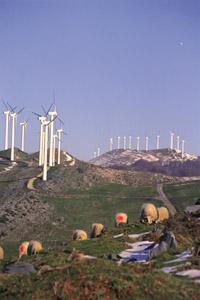Wind plans

For some reason, renewable energy is a recurring issue. The aim of the European Union is that in 2012 12% of energy is obtained from renewable sources. Wind energy is one of the energies that are being driven for it. In this cemetery, the Basque Government is developing the Territorial Sectoral Plan of Wind Energy (PTS). This article explains the scope of the PTS and does not mention the suitability of the PTS or wind energy, as for this you can access the number 133-134 of Elhuyar.
Renewable energies have received a greater boost the renewal of the mini hydraulic plants, the use of urban waste (incinerators, biogas...) and, above all, the use of wind energy. However, the regulations around these energy sources are not fully consolidated and must be carried out at all times or in relation to specific projects.
Regarding wind energy, the Administration of the Autonomous Community of the Basque Country is developing the Territorial Sectoral Plan of Wind Energy (PTS) that would cover this gap. The objectives of the PTS are: 1) identify and select the appropriate locations for wind farms, 2) integrate them into the general management of the territory, 3) coordinate existing interests and 4) analyze possible locations not contemplated in the PTS in preparation and establish the steps and criteria for their viability. The PTS will have to overcome a six main steps process before its approval, which is currently in a second step, as it is receiving amendments from public administrations. The deadline for submitting the amendments will be two months and one more month. Finally, the whole process will end in early summer next year. However, the Department of Industry of the Basque Government is expected that before the final approval of the PTS companies will begin to offer wind farms.
Development and current situation
The Sectoral Territorial Plan for Wind Energy was launched in March 1997. The non-legislative proposal adopted by the Basque Parliament on 20-03-97 urges the Government to prepare the PTS as soon as possible. For its part, the 3E-2005 Energy Plan foresees, among other actions, the installation of 175 MW by wind power by 2005, with the aim of producing 437,500 mw.h annually.
The wind farm on Mount Elgea-Urkilla was built without the specific regulation of wind farms, without the PTS. Therefore, it had to comply with a special plan, similar to the one that the possible sites not included in the PTS should comply with.
Taking these points into account, a PTS has been developed that would regulate wind farms that meet the following requirements: Wind farms with 5 wind turbines, access to the general power grid and 10 MW of installed power. The objectives are those mentioned at the beginning and they include:
1) Wind measurements in the CAPV,
2) identification, suitability analysis and site selection,
3) the existing building conditions at the selected sites,
4) the construction conditions in unselected locations,
5) the consolidation of the new urban planning and
6) its impact on current plans.
The first condition for the construction of wind farms is the existence of wind, with an annual average of 6.3-6.4 m/s. This speed and orientation have identified 29 potential sites (see table 1). 243.6 km in total, with an installed power of 1.234 MW. The suitability of these sites will then be analyzed and selected. The parks or park sections found in the rocks (28.9% of the initial potential) have been directly rejected. In the environmental field, the advance of the PTS has taken into account protection figures (only excluding those of protected natural spaces, recreation areas, cliffs with raptors and natural forests; 29.4% of total potential), cultural heritage, noise, landscape, use of space, geodesic vertices, birds, vegetation and threatened flora.
In addition to the environmental condition, the technical-economic part of the possible sites (expenses, benefits, production, etc.) has been analyzed. and by combination of both have been ruled out 16 possible sites. Therefore, 13 would receive approval (see table 2).
These sites are approved by the Department of Industry, Commerce and Tourism of the Basque Government. As mentioned above, the PTS will also establish the steps to follow for the construction of the parks, both for the 13 locations it considers most suitable and for others possible. In general, they must meet the same requirements and, if several projects are presented for the same environment, the PTS will prioritize the least environmental impact and greater energy efficiency.
The present PTS object of study has an indefinite validity, but it can be revised or modified so that its obsolescence with the reality or the loss of value of the criteria used for its elaboration can be appreciated. In any case, your review will be reviewed every eight years or not.
Brushstrokes
o Installed power in the world: 13.455 MW
o Annual production worldwide: 27,000 gw.h
o 69% of world wind energy is produced in Europe.
o In Elgea-Urkilla, 650 kW generators have been installed and 1,000 kW generators are already being studied.
o Navarra has 408.4 MW of power installed, with a total of 627 wind turbines. During the period 2000-2003, another 329 wind turbines (241 MW) have been authorized.
or E.H.N. has explained its intention to build in Codes a park of 194 wind turbines.
o By law, all electricity produced by wind energy (and other renewables) enters the network, while the electricity produced by other systems includes the one acquired by auction.
o If the Plan 3E-2005 (175 MW for 2005) was fulfilled, 3% of the energy needs would be produced through wind energy in the ACBC.
o Wind turbines will be installed in the CAPV on land over 800 m, where the human being is less exposed and there are more plots better conserved.
o Social sectors have shown a contrary position, usually not against wind energy, but against certain sites, criteria and behaviors.





